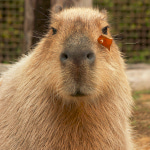Capybara Appreciation Day Date in the current year: July 10, 2026
 Capybara Appreciation Day is a fun holiday celebrated annually on July 10. It was created to pay tribute to the world’s largest rodent known for its love for water and cute appearance.
Capybara Appreciation Day is a fun holiday celebrated annually on July 10. It was created to pay tribute to the world’s largest rodent known for its love for water and cute appearance.The greater capybara or simply capybara (Hydrochoerus hydrochaeris) is a giant rodent from the cavy family whose closest relatives are the lesser capybara, guinea pigs, and rock cavies. Capybaras are native to South America and are found in all countries on the continent except Chile.
As we’ve already mentioned, the capybara is the largest extant rodent. Adult animals grow to up to 134 cm in length, stand to up to 62 cm tall at the withers, and can weigh up to 66 kg. The average lifespan of the capybara is about 4 years in the wild (due to predators such as jaguars, pumas, caimans, anacondas, and eagles) and up to 12 years in captivity.
Capybaras are semi-aquatic animals that inhabit dense forests near bodies of water, such as rivers, lakes, ponds, swamps, and marshes. They are excellent swimmers capable of holding their breath underwater for up to 5 minutes at a time, which helps them avoid predators. They can even sleep in water with only their noses, eyes, and ears out.
Capybaras tend to spend the time wallowing in water or mud when the weather is hot to keep themselves cool and feed in the late afternoon and early evening, as well as before dawn after a night’s rest. Capybaras are herbivores that eat mainly grasses, aquatic plants, fruit, and tree bark. They usually feed on different plants during the dry season and during the wet season. Like other rodents, their front teeth never stop growing to compensate for the constant wear from chewing plants. Their molars also grow continuously.
Capybaras are highly social animals that prefer to live in groups commonly consisting of about 10–20 individuals, although there are groups as large as 50 and even 100 individuals. These groups are stable and work together to defend their habitat and protect their young from predators. Female capybaras even raise their cubs together.
Capybaras are very vocal and communicate using a wide range of sounds, including barking, chirping, clicking, crying, huffing, purring, squealing, teeth-chattering, whining, and whistling. Each sound has a different meaning, but what’s most fascinating is that these meanings are specific to each social group.
The International Union for the Conservation of Nature lists the capybara as a species of the least concern. Even though capybaras are hunted for their pelt and meat in some areas, their ability to breed rapidly compensates for it. They can be found in many zoos and parks around the world.
The origin of Capybara Appreciation Day is murky, but no one can deny that this amazing animal deserves to be celebrated. You can learn interesting facts about capybaras and share them with anyone who is willing to listen, check out capybaras at your local zoo, watch capybara videos on YouTube or TikTok, and post cute capybara photos or capybara memes on social media with the hashtag #CapybaraAppreciationDay to spread the word.
- Category
- Ecological Observances, Unofficial Holidays
- Tags
- Capybara Appreciation Day, unofficial holidays, capybaras, facts about capybaras, environmental observances